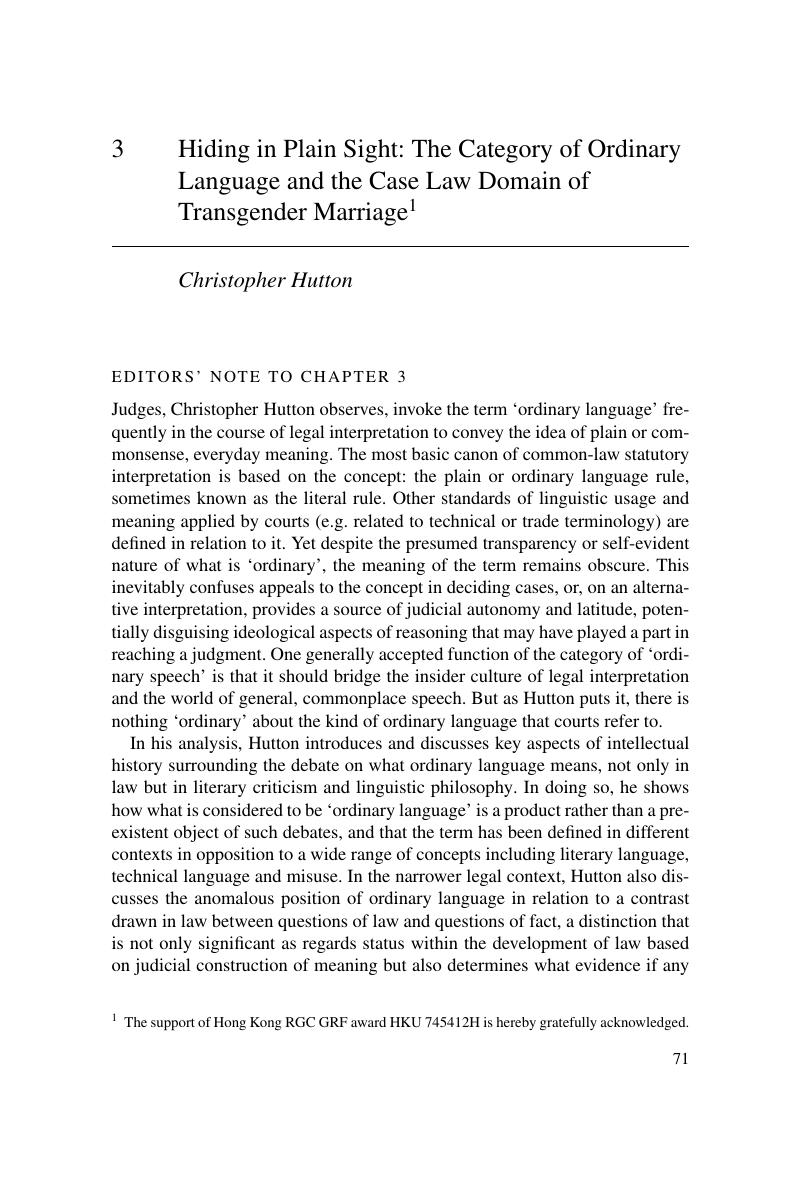from Part I - Sui generis or Socially Problematic: The Character of Legal Language
Published online by Cambridge University Press: 28 December 2017

Anonymous v Anonymous 67 Misc.2d 982, 325 N.Y.S.2d 499 (N.Y. Sup. Ct. 1971).
Attorney-General (Cth) v “Kevin and Jennifer” [2003] Fam CA 94.
Bellinger v Bellinger [2001] EWCA Civ 1140. 2003 WL 1610368 (2003).
Brutus v Cozens [1973] AC 854.
Corbett v Corbett [1971] 2 All ER 33.
Goodwin v United Kingdom (2002) 35 EHRR 18.
Kantaris v Kantaris 84 So. 2d 155 (2004).
Littleton v Prange 9 S.W.3d 223 (Tex. App.–San Antonio 1999).
M.T. v T.J. 40 N.J. Super. 77 (1976).
Nix v Hedden 149 U.S. 304 (1893).
R v Harris (1988) 17 NSWLR 158.
R (Quintavalle) v Secretary of State for Health [2003] 2 AC 687.
Re Kevin 165 FLR 404 (2001).
Re Ladrach 32 Ohio Misc.2d 6 (1987).
re the Estate of Marshall G. Gardiner 73 Kan. 191, 42 P.3d 120 (2002).
Secretary, Department of Social Security v State Railroad Authority (1993) 43 FCR 299.
S Y v S Y [1963] P 37, [1962] 3 WLR 526.
Talbot (otherwise Poyntz) v Talbot, John David (otherwise Talbot, Mabel) (1967) 111 S.J. 213.
W v Registrar of Marriages (CACV 266/2010).
W v The Registrar of Marriages [2013] HKCFA 39.
Anonymous v Anonymous 67 Misc.2d 982, 325 N.Y.S.2d 499 (N.Y. Sup. Ct. 1971).
Attorney-General (Cth) v “Kevin and Jennifer” [2003] Fam CA 94.
Bellinger v Bellinger [2001] EWCA Civ 1140. 2003 WL 1610368 (2003).
Brutus v Cozens [1973] AC 854.
Corbett v Corbett [1971] 2 All ER 33.
Goodwin v United Kingdom (2002) 35 EHRR 18.
Kantaris v Kantaris 84 So. 2d 155 (2004).
Littleton v Prange 9 S.W.3d 223 (Tex. App.–San Antonio 1999).
M.T. v T.J. 40 N.J. Super. 77 (1976).
Nix v Hedden 149 U.S. 304 (1893).
R v Harris (1988) 17 NSWLR 158.
R (Quintavalle) v Secretary of State for Health [2003] 2 AC 687.
Re Kevin 165 FLR 404 (2001).
Re Ladrach 32 Ohio Misc.2d 6 (1987).
re the Estate of Marshall G. Gardiner 73 Kan. 191, 42 P.3d 120 (2002).
Secretary, Department of Social Security v State Railroad Authority (1993) 43 FCR 299.
S Y v S Y [1963] P 37, [1962] 3 WLR 526.
Talbot (otherwise Poyntz) v Talbot, John David (otherwise Talbot, Mabel) (1967) 111 S.J. 213.
W v Registrar of Marriages (CACV 266/2010).
W v The Registrar of Marriages [2013] HKCFA 39.
To save this book to your Kindle, first ensure no-reply@cambridge.org is added to your Approved Personal Document E-mail List under your Personal Document Settings on the Manage Your Content and Devices page of your Amazon account. Then enter the ‘name’ part of your Kindle email address below. Find out more about saving to your Kindle.
Note you can select to save to either the @free.kindle.com or @kindle.com variations. ‘@free.kindle.com’ emails are free but can only be saved to your device when it is connected to wi-fi. ‘@kindle.com’ emails can be delivered even when you are not connected to wi-fi, but note that service fees apply.
Find out more about the Kindle Personal Document Service.
To save content items to your account, please confirm that you agree to abide by our usage policies. If this is the first time you use this feature, you will be asked to authorise Cambridge Core to connect with your account. Find out more about saving content to Dropbox.
To save content items to your account, please confirm that you agree to abide by our usage policies. If this is the first time you use this feature, you will be asked to authorise Cambridge Core to connect with your account. Find out more about saving content to Google Drive.